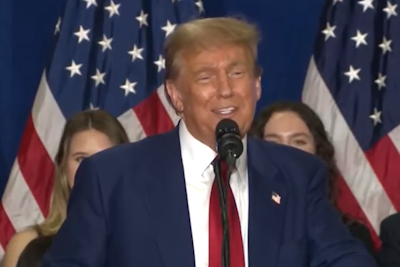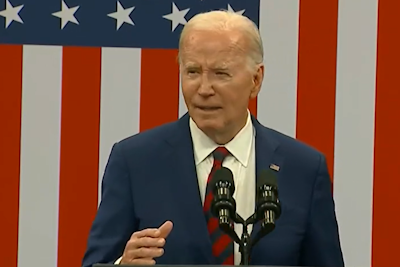Para leer en español, vea esta traducción de El Tiempo Latino.
We’ve fact-checked a lot of claims from the presumptive Democratic and Republican presidential nominees — after all, they’re the same two men who faced off in 2020. Some of President Joe Biden’s and former President Donald Trump’s assertions are well-worn talking points they will likely continue to trot out on the campaign trail.
As a primer for the 2024 election, here’s our guide to the top 10 falsehoods and distortions — so far — in terms of Trump’s and Biden’s propensity to repeat them.
No ‘Rigged Election’
At just about every opportunity, Trump makes the false claim that the 2020 election was “rigged,” claiming that he and his allies “found tremendous voter fraud” in swing states that he lost, such as Pennsylvania, Wisconsin and Georgia.

But there is no evidence to support Trump’s claims, and, in fact, there is ample evidence that the 2020 election was — in the words of the Trump administration’s own Cybersecurity and Infrastructure Security Agency — “the most secure in American history.”
The fact is, Trump and his allies lost more than 60 lawsuits challenging the election results. In Georgia, for example, Trump not only lost 11 post-election lawsuits, but a statewide hand audit and a machine recount. “Georgia’s historic first statewide audit reaffirmed that the state’s new secure paper ballot voting system accurately counted and reported results,” Secretary of State Brad Raffensperger, a Republican, said in announcing the results of the audit on Nov. 19, 2020.
William Barr, who served as the U.S. attorney general under Trump, told a House committee in testimony released June 13, 2022: “In my opinion then, and my opinion now, is that the election was not stolen by fraud, and I haven’t seen anything since the election that changes my mind on that.”
Barr gave that testimony to the House select committee investigating the Jan. 6, 2021, riot at the U.S. Capitol. Like Barr, other top Justice Department officials in the Trump administration testified that they repeatedly told Trump the department found no evidence of widespread election fraud. For example, Richard Donoghue, who was deputy attorney general under Trump, told the Jan. 6 committee that he tried “to put it in very clear terms to the president” that “major allegations” of fraud in Georgia, Pennsylvania, Michigan and Nevada were “not supported by the evidence.” (For more, see our June story “Trump Ignored Aides, Repeated False Claims.”)
Yet, Trump has made baseless claims about a stolen election a key part of his 2024 campaign.
Deficit Decline Due to Pandemic Spending
Biden often misleadingly suggests that his administration is responsible for the federal budget deficit declining from about $3.1 trillion in fiscal year 2020 to about $1.7 trillion in fiscal 2023. “Our administration has already cut the deficit by $1 trillion,” he said during April 9 remarks from Washington, D.C.
But as we’ve written, the large decline in the deficit had more to do with expiring emergency COVID-19 funding than it did with Biden’s policies. Experts have said that his push for more pandemic and infrastructure spending early in his presidency increased deficits. The drop that Biden cites would have been larger in fiscal 2021 and fiscal 2022 if not for his policies.
Unsupported Illegal Immigration Claim
Virtually every campaign speech Trump has delivered for more than a year has included some version of the unsupported claim that countries around the world are “emptying out their prisons, insane asylums and mental institutions and sending their most heinous criminals to the United States.” As we have reported, immigration experts say they have not seen evidence to support that.

Trump has offered scant evidence to back up his claim, at various times claiming to have read media reports that support it — but which journalists, including those at FactCheck.org, have been unable to locate and the Trump campaign has failed to provide.
More recently, in a speech in Green Bay on April 2, Trump cited a drop in violent crime in Venezuela as circumstantial evidence that “they’re taking their gangs and their criminals and depositing them very nicely into the United States.”
The Venezuelan Observatory of Violence, which has access to the country’s crime data, reported a 25% decrease in violent deaths between 2022 and 2023. But the group’s founder and director, Roberto Briceño-León, told us via email, “We have no evidence that the Venezuelan government is emptying the prisons or mental hospitals to send them out of the country, whether to the USA or any other country.”
Rather, he said, the drop in crime is due to worsening economic and living conditions in the country, which has led to a massive out-migration of nearly 8 million people.
“Crime is reduced in Venezuela due to a reduction in crime opportunities: bank robberies disappear because there is no money to steal; kidnappings are reduced because there is no cash to pay ransoms; robberies on public transportation cease because travelers have no money in their pockets and old, worthless cell phones; and assaults on bank money dispensers disappear because the cash they can give to their clients has not exceeded twenty US dollars,” Briceño-León said.
Some criminals have left Venezuela “seeking to continue their criminal life in other places where they find greater opportunities for profit,” he said, but the vast majority of emigrants from Venezuela are “honest workers fleeing the country’s poverty, looking for a job and a better future.”
Misleading Jobs Comparison
In speeches and on social media, Biden continues to misleadingly contrast the jobs gained during his presidency with the job losses under Trump — ignoring that the loss under Trump was because of the COVID-19 pandemic.
Here’s a chart that has been pushed out by the White House:
The great American comeback continues under President Biden. pic.twitter.com/DVSoLeahQT
— The White House (@WhiteHouse) March 12, 2024
The economy under Biden has added about 15.2 million jobs between January 2021 and March, according to the Bureau of Labor Statistics. That comes out to about 400,000 jobs a month, as the chart says. And Trump’s number is correct, looking at the entirety of his time in office. But under Trump, jobs were growing at an average of about 180,000 per month until the pandemic hit. The U.S. lost 20.5 million jobs in April 2020, as efforts to slow the spread of the novel coronavirus led to business closures and layoffs.
It wasn’t until June 2022, under Biden, that employment numbers reached their pre-pandemic levels.
On the campaign trail, Biden also frequently boasts that the 15 million jobs added in his first three years “is a record in American history.” While that may be true in raw numbers, in terms of the percentage of job growth, which accounts for population growth, the first three years under Presidents Jimmy Carter (12.5%) and Lyndon Johnson (12.1%) were higher than Biden’s 10.3% so far.
Still ‘Energy Independent’
Trump regularly makes the misleading claim that the U.S. was “energy independent” during his term, suggesting that is no longer the case under Biden. In his Super Tuesday victory speech on March 5, Trump said, “Three years ago … we were energy independent. We were going to be very shortly energy dominant, and today we’re getting oil from Venezuela.”
But under Trump, the U.S. never stopped importing sources of energy, including crude oil, from other countries. In addition, as the country did when Trump was president, the U.S., during Biden’s presidency, has exported more energy, including petroleum, than it imported, and it has produced more energy than it consumed. Those are ways some people define “energy independence,” and the U.S. still meets those metrics.
Also, the U.S. is producing record amounts of oil and natural gas under Biden, contrary to claims that his policies “crushed” American energy.
No Plans to Cut Medicare, Social Security
Increasingly, Biden makes the unsupported claim that Trump wants to cut Medicare and Social Security.
As we wrote, Biden in December claimed Trump “is proposing …. cutting Social Security and Medicare,” even though the former president has said he has no plan to cut either program and has publicly warned Republicans not to do so.

More recently, Biden repeatedly points to a single statement that Trump made in March to claim he has proof that Trump wants to cut Social Security and Medicare. “So first of all, there is a lot you can do in terms of entitlements in terms of cutting and in terms of also the theft and the bad management of entitlements, tremendous bad management of entitlements,” Trump said in a March 11 interview on CNBC.
Biden excerpted part of that quote on at least three occasions in March while in North Carolina, Texas and New Hampshire.
But in context, the Trump campaign said, the former president was talking about cutting waste and fraud in those programs – not benefits. And there is evidence to support the Trump campaign.
Trump has consistently stated his opposition to cutting Social Security and Medicare. When he first ran for president in 2015, he said he would “get rid of the waste and fraud” and “save” the programs “without cuts.”
As an aside, experts have told us that Social Security cannot be “saved” by simply cutting waste and fraud.
When House Republicans in early 2023 began to debate among themselves how to reduce government spending, Trump said in a video post on Jan. 20: “Under no circumstances should Republicans vote to cut a single penny from Medicare or Social Security to help pay for Joe Biden’s reckless spending spree.”
Some critics argue that Trump’s words cannot be trusted because of the budgets he proposed as president. But, as we have written, Trump did not propose cuts to Social Security retirement benefits, and his budgets included only bipartisan ideas to reduce the growth of Medicare spending.
Another aside: Trump, too, has made similar claims about Biden. Earlier this month, he told supporters in Wisconsin, “Unlike Biden and the open borders Democrats, I will always protect Medicare and Social Security for our great seniors.” There is no support for the idea that Biden wants to cut the programs’ benefits, either.
An Abortion Distortion
Trump falsely claims that Democrats support abortion “even after birth,” as he said in Iowa in January. More recently, he made the claim in an April 8 video, saying: “The baby is born, the baby is executed after birth.” That’s homicide, and it’s illegal.
“No such procedure exists,” the American College of Obstetricians and Gynecologists says on its website.
The former president has wrongly said that this was permitted under Roe v. Wade, the Supreme Court ruling that established a constitutional right to abortion. It was not.
Under Roe, states could outlaw abortion after fetal viability, but with exceptions for risks to the life or health of the mother. As we’ve explained, many Republicans have objected to the health stipulation, saying it would allow abortion for any reason. Democrats say it’s an exception for medical risks for the mother. But Trump’s extreme claim of abortion “after birth” goes well beyond the GOP viewpoint that the health exception is a loophole.
In June 2022, after Trump had appointed three conservative justices to the Supreme Court, the court overturned Roe in a 5-4 ruling. Biden supports restoring Roe as “the law of the land,” as he said in his State of the Union address.
Billionaires Pay Higher Federal Tax Rates
As part of his proposal for a billionaire minimum tax, Biden routinely says that billionaires pay an average federal tax rate of about 8%, “less than a teacher or a firefighter,” as he said in February. In the State of the Union address, he included “a sanitation worker, or a nurse.” He leaves the misleading impression that billionaires pay that tax rate under the current tax system. Instead, the figure comes from a White House calculation that factors in earnings on unsold stock as income.
When looking only at income, the top-earning taxpayers, on average, pay higher tax rates than those in the income groups below them, as we’ve explained. Earnings on assets, such as stock, aren’t taxed until that asset is sold, at which point the earnings are subject to capital gains taxes. Biden has proposed that those with wealth over $100 million pay a 25% minimum tax, as calculated on both standard income and unsold investment income combined.
The problem with the current system, the White House has said, is that unrealized gains could go untaxed forever if wealthy people hold on to them and pass them on to heirs when they die. At the time of an inheritance, an asset’s value is adjusted to the fair market value, essentially eliminating any taxes on the gains that had accumulated from the time the asset was purchased and when it was passed on to heirs.
Not the ‘Greatest Economy’
Trump repeatedly makes the false claim that under his leadership the U.S. had the “greatest economy in history” — a claim he made throughout his time in office. On his last day in office and in his first speech announcing his 2024 campaign, Trump said he “built the greatest economy in the history of the world.” He repeated that claim recently at a rally in Ohio.
But it’s not true.
Economists generally measure a nation’s health by the growth of its inflation-adjusted gross domestic product. Under Trump, growth was modest. Real GDP in Trump’s four years grew by 2.5% in 2017, 3% in 2018 and 2.5% in 2019 — before the economy went into a tailspin during the pandemic in 2020, when real GDP declined by 2.2%, according to the Bureau of Economic Analysis.
So, at best, U.S. real GDP grew annually by 3% under Trump. By contrast, the nation’s economy grew at a faster annual rate 48 times and under every president before and after Trump dating to 1930, except Barack Obama and Herbert Hoover. The economy grew at more than 3% six of Ronald Reagan’s eight years, including 7.2% in 1984, and it grew 5% or more 10 times under Franklin D. Roosevelt, including 18.9% in 1942.
Misleading on Preexisting Conditions and the ACA
Just as he did during the 2020 campaign, Biden continues to tout the benefits of the Affordable Care Act and claims Trump wants to end it. His go-to, and misleading, talking point: “100 million Americans can no longer be denied health insurance because of a preexisting condition because of that law,” as he said March 9 in Atlanta, adding that Trump “wants to repeal” the ACA.
The ACA greatly expanded protections for those with preexisting conditions: It barred insurers in all markets from denying coverage or charging more based on someone’s health status. But those protections were most important for the individual, or nongroup, market, where people buy their own coverage. About 20 million Americans were in that market in 2022. Before the ACA, employer plans couldn’t deny a policy to an employee. If a new employee had a lapse in insurance coverage, they could decline coverage for some preexisting conditions for a limited period.
The 100 million figure is an estimate of how many Americans not on Medicare or Medicaid have preexisting conditions. But, again, if the ACA were repealed, only those buying their own plans on the individual market would be at risk of being “denied health insurance.”
As for Trump, he has said he wants to get rid of the law, posting on social media in November that Republicans “should never give up” on terminating the ACA. More recently, in late March, Trump said he wanted to make the ACA better and cheaper. But he hasn’t released a health care plan.
Correction, April 16: Since 1930, real annual GDP growth in the U.S. failed to exceed 3% under Presidents Hoover, Obama and Trump. We corrected this article to add Obama to that short list. We thank the reader who brought the error to our attention.
Editor’s note: FactCheck.org does not accept advertising. We rely on grants and individual donations from people like you. Please consider a donation. Credit card donations may be made through our “Donate” page. If you prefer to give by check, send to: FactCheck.org, Annenberg Public Policy Center, P.O. Box 58100, Philadelphia, PA 19102.